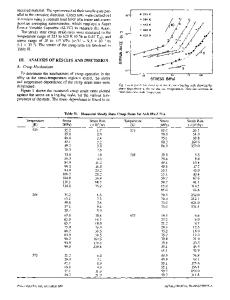Microstructure and Phase Formation in a Rapidly Solidified Laser-Deposited Ni-Cr-B-Si-C Hardfacing Alloy
- PDF / 2,585,685 Bytes
- 15 Pages / 593.972 x 792 pts Page_size
- 41 Downloads / 243 Views
TION
Ni-BASE self-fluxing alloys containing Cr, B, Si, and C are among the most widely used hardfacing alloys for wear and corrosion protection.[1–4] Hardness and toughness of these alloys depend on the content of Cr, B, Si, and C. The high-alloy grades of the family contain high quantities of Cr (more than 10 wt pct) and a low ratio of Si to B (Si/B < 3).[5] These alloys have been traditionally deposited using various thermal spray techniques. However, laser deposition technologies have also been used in recent years to produce dense Ni-Cr-B-Si-C coatings with metallurgical bonding to the substrate and superior functional properties.[2,3,6] The microstructure of the high-alloy grades of Ni-CrB-Si-C laser-deposited coatings consists of a complex mixture of several boride and carbide precipitates along with Ni solid solution dendrites and various binary and ternary Ni-B-Si eutectics.[7] Our previous work showed that the high-alloy grades of the Ni-Cr-B-Si-C family have the tendency to develop multiple microstructures from approximately constant alloy chemistry.[6] Detailed phase identification confirmed that the microstructural changes were not only morphological variations but also changes in the type of the constituent phases.[7] In fact, this explains the diversity of the reports in the literature on the microstructure and phase ISMAIL HEMMATI, Ph.D. Student, VA´CLAV OCELI´K, Research Fellow, and JEFF TH. M. DE HOSSON, Professor, Head of Materials Science Group, are with the Department of Applied Physics, Materials innovation institute (M2i), University of Groningen, Nijenborgh 4, 9474 AG Groningen, The Netherlands. Contact e-mail: [email protected] KORNEL CSACH, Head of Department, is with the Institute of Experimental Physics, Slovak Academy of Sciences, Watsonova 47, 040 01 Kosice, Slovakia. Manuscript submitted January 24, 2013. Article published online September 25, 2013 878—VOLUME 45A, FEBRUARY 2014
constitution of laser-clad Ni-Cr-B-Si-C alloys with comparable chemistries.[4,8–11] The variation in the type and morphology of the constituent phases can be due to changes in chemistry of the alloy or the thermal conditions during solidification. In laser deposition of a fixed alloy composition (e.g., a prealloyed metal powder or wire), compositional changes are mainly caused by various levels of dilution from the substrate.[12] For the deposition on carbon steel substrates, various levels of dilution is equivalent to different percentages of iron in the meltpool. Effects of dilution from the steel substrate on the microstructure and phase formation of the alloy of this study were previously studied by us and published elsewhere.[12] While the effects of dilution on this alloy system are pronounced mainly at dilutions of more that around 20 pct, even minor variations of thermal conditions during the deposition process may significantly change the properties of Ni-Cr-B-Si-C alloys as will be discussed later. The focus of the current work is on studying the effects of various thermal conditions on the microstructure and phas
Data Loading...











